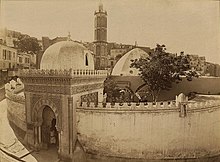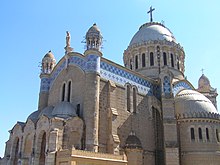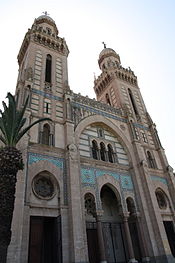| Part of a series on the |
| Culture of Algeria |
|---|
 |
| People |
Contents
Islam
Pasha mosque in Oran
Since the mid-20th-century Algerian War, led by the French, also called the Algerian Revolution, regimes have sought to develop an Islamic Arab socialist state, and a cabinet-level ministry acts for the government in religious affairs. Although the Boumediene regime consistently sought, to a far greater extent than its predecessor, to increase Islamic awareness and to reduce Western influence, the rights of non-Muslims continued to be respected. The Bendjedid government pursued a similar policy.[3]
Early history
Before the Arab incursions, most of the Berber inhabitants of the area's mountainous interior adopted traditional Berber mythology. Some had adopted Judaism, and in the coastal plains many had accepted Christianity under the Romans. St. Augustine of Hippo, one of the most important theologians in Roman Catholicism, was born in Thagaste (Souk Ahras) and taught in Hippo (Annaba). A wave of Arab incursions into the Maghreb in the latter half of the 7th century and the early 8th century introduced Islam to parts of the area.[4]During the 7th century, Muslims reached North Africa, and by the beginning of the 8th century the Berbers had been for the most part converted to Islam. Sunni Islam, the larger of the two great branches of the faith, is the form practiced by the overwhelming majority of Muslims in Algeria, while there is a small Ibadi minority. There is no significant Shia presence.[4]
One of the dominant characteristics of Islam in North Africa was the cult of holy men, or maraboutism. Marabouts were believed to have barakah, or divine grace, as reflected in their ability to perform miracles. Recognized as just and spiritual men, marabouts often had extensive followings, locally and regionally. Muslims believed that baraka could be inherited, or that a marabout could confer it on a follower.[4]
The turuq, meaning way or path, or brotherhoods, were another feature of Islam in the Maghreb from the Middle Ages onward. Each brotherhood had its own prescribed path to salvation, its own rituals, signs, symbols, and mysteries. The brotherhoods were prevalent in the rural and mountainous areas of Algeria and other parts of North Africa. Their leaders were often marabouts or shaykhs. The more orthodox Sunni Muslims dominated the urban centers, where traditionally trained men of religion, the ulema, conducted the religious and legal affairs of the Muslim community.[4]
Islam and the Algerian state
Jews and Christians, whose religions Allah according to the Qur'an recognized as the precursors of Islam and who were called "people of the book" because of their holy scriptures, were permitted to continue their own communal and religious life as long as they recognized the temporal domain of Muslim authorities, paid their taxes, and did not proselytize or otherwise interfere with the practice of Islam.[5]Soon after arriving in Algeria, the French colonial regime set about undermining traditional Muslim Algerian culture. The French ideas such as freedom of religion, however, vastly differed from the Islamic way of living. For this reason, Islam was a strong element of the resistance movement to the French.[5]
After independence, the Algerian government asserted state control over religious activities for purposes of national consolidation and political control. Islam became the state religion in the new constitution and the religion of its leaders. No laws could be enacted that would be contrary to Islamic tenets or that would in any way undermine Islamic beliefs and principles. The state monopolized the building of mosques, and the Ministry of Religious Affairs controlled an estimated 5,000 public mosques by the mid-1980s. Imams were trained, appointed, and paid by the state, and the Friday khutba, or sermon, was issued to them by the Ministry of Religious Affairs. That ministry also administered religious property, the habus, provided for religious education and training in schools, and created special institutes for Islamic learning.[5]
Those measures, however, did not satisfy everyone. As early as 1964, a militant Islamic movement, called Al Qiyam (values), emerged and became the precursor of the Islamic Salvation Front of the 1990s. Al Qiyam called for a more dominant role for Islam in Algeria's legal and political systems and opposed what it saw as Western practices in the social and cultural life of Algerians.[5]This proved to be the most difficult challenge for the immediate post-independent regimes as they tried to incorporate an Islamic national identity alongside socialist policies. Whereas the new leaders of Algeria saw Islam and Socialism as both compatible and features of Algerian culture and society; radical Islamists saw Islam as the only defining characteristic and in fact incompatible.[6]
Henri Boumediene largely contained militant Islamism during his reign, although it remained throughout the 1970s under a different name and with a new organization. Following Boumediene's death, Chadli Bendjedid became president in 1979. Chadli's regime was much more tolerant with Islamists, and with Algeria in the midst of an socio-economic crisis including unemployment and inflation, social tensions were high. Policies of Arabization (increasing Arabic education and the use of Arabic in professional institutions) had failed to come to fruition: French remained the language of the political elite and French speaking students were prioritised for jobs.[7] Thus, the movement began spreading to university campuses, where it was encouraged by the state as a counterbalance to left-wing student movements. By the 1980s, the movement had become even stronger, and in November 1982, bloody clashes erupted at the University of Algiers in Algiers. The violence resulted in the state's cracking down on the movement, a confrontation that would intensify throughout the 1980s and early 1990s (see The Islamist Factor, ch. 4).[5]
The rise of Islamism had a significant impact on Algerian society. More women began wearing the veil, some because they had become more conservative religiously and others because the veil kept them from being harassed on the streets, on campuses, or at work. Islamists also prevented the enactment of a more liberal family code despite pressure from feminist groups and associations.[5]
Religious minorities
Notre Dame d'Afrique (Our Lady of Africa) is a Roman Catholic church that is the basilica of Algiers
Basilica St.Augustine in Annaba built not far from the remains of his Basilica Pacis
The Bahá'í Faith in Algeria dates from 1952.[9] Though the religion achieved some growth and organization through 1967 including converts,[9] the period of the independence of Algeria when the country adopted Islamic practices in rejection of colonial influences[10] and subsequently the religion was effectively banned in 1968.[11] However more recently the Association of Religion Data Archives and Wolfram Alpha estimated the population of Bahá'ís at 3.3[12]–3.8[13] thousand Bahá'ís in 2005 and 2010.
The Jewish community of Algeria is of considerable antiquity, with some members claiming descent from immigrants from Palestine at the time of the Romans. The majority are descendants of refugees from Spanish persecution early in the fifteenth century. They numbered about 140,000 before the Algerian War, but at independence in 1962 nearly all of them left the country. Because the 1870 Crémieux Decrees, which aimed at assimilating the colonists of Algeria to France, gave Jews full French citizenship, most members of the Jewish community emigrated to France.[8] The small remaining Jewish population appeared to have stabilized at roughly 1,000. It was thought to be close to this number in the early 1990s. Although no untoward incidents occurred during the Arab-Israeli wars of 1967 and 1973, a group of youths sacked the only remaining synagogue in Algiers in early 1977.[8]
A 2015 study estimates some 380,000 Christian believers from a Muslim background in the country, most of whom subscribe to some form of evangelical Christianity.[14]
See also
References
- Johnstone, Patrick; Miller, Duane Alexander (2015). "Believers in Christ from a Muslim Background: A Global Census". IJRR. 11 (10): 1–19. Retrieved 30 October 2015.



Comments
Post a Comment